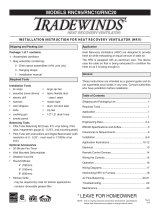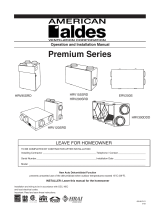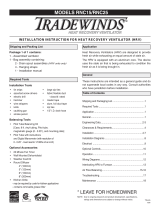www.lifebreath.com 5
2 SELECTING THE VENTILATION THAT IS RIGHT FOR YOU
Operating Modes
The modes of operation and speeds are used to adjust your indoor ventilation rate. Experiment with
the ventilation levels in your home to evaluate the ideal amount of ventilation to suit your home and
personal preferences. Operational modes available to you will depend on the main control that is installed.
Some features and modes may be unavailable to you.
1) Continuous Ventilation
This mode of operation provides continuous ventilation within the home. You may, for example, select
Continuous Ventilation at low speed for normal operation and increase to high speed during increased
activity levels, such as cooking and showering, etc.
2) 20 Minutes On, 40 Minutes Recirculation
This mode ventilates for 20 minutes and recirculates the household air every 40 minutes each hour.
This mode is not applicable if your HRV is connected to a forced air system.
3) 20 Minutes On, 40 Minutes Standby
This mode of operation provides 20 minutes of ventilation each hour. You can use this ventilation mode
at low speed for low household activity levels or when the home is unoccupied.
4) 10 Minutes On, 50 Minutes Standby
This mode of operation provides 10 minutes of ventilation each hour. You can use this ventilation mode
at low speed for low household activity levels or when the home is unoccupied. This mode is useful
when 20/40 mode is providing too much ventilation.
5) Continuous Recirculation
This mode continuously recirculates your household air (no ventilation). This mode is not applicable if
your HRV is connected to a forced air system.
6) Continuous Low Fan Speed
This mode will operate the fan in low speed continuously at the selected operating mode (Ventilation or
Recirculation)
7) Continuous High Fan Speed
This mode will operate the fan in high speed continuously at the selected operating mode (Ventilation
or Recirculation). This mode is useful when occupancy in the home or activity is high for an extended
period.
Recirculation
Recirculates existing household air without introducing fresh air. Recirculation modes
(2 and 5) are not applicable if your HRV is connected to a forced air system, since your forced air system
already circulates the household air. Recirculation modes are unavailable on some models.





















